 Charter of the Rights of NationsInscribed on a clay cylinder in cuneiformdiscovered in 1879 now in The British Museum, London.
Charter of the Rights of NationsInscribed on a clay cylinder in cuneiformdiscovered in 1879 now in The British Museum, London.He also declared the first Charter of Human Rights known to mankind, which is written on a clay cylinder:
"I am Cyrus, king of the world, great king, mighty king, king of Babylon, king of the land of Sumer and Akkad, king of the four quarters, son of Cambyses, great king, king of Anshan, grandson of Cyrus, great king, king of Anshan, descendant of Teispes, great king, king of Anshan, progeny of an unending royal line, whose rule Bel and Nabu cherish, whose kingship they desire for their hearts' pleasures.
When I, well-disposed, entered Babylon, I established the seat of government in the royal palace amidst jubilation and rejoicing. Marduk, the great God, caused the big-hearted inhabitants of Babylon to...me. I sought daily to worship him. My numerous troops moved about undisturbed in the midst of Babylon.
I did not allow any to terrorize the land of Sumer and Akkad. I kept in view the needs of Babylon and all its sanctuaries to promote their well-being. The citizens of Babylon... I lifted their unbecoming yoke. Their dilapidated dwellings I restored. I put an end to their misfortunes.
At my deeds Marduk, the great Lord, rejoiced, and to me, Cyrus, the king who worshipped, and to Cambyses, my son, the offspring of my loins, and to all my troops, he graciously gave his blessing, and in good spirit is before him we/glorified/exceedingly his high divinity.
All the kings who sat in the throne rooms, throughout the four quarters, from the Upper to the Lower Sea, those who dwelt in ... all the kings of the West Country who dwelt in tents, brought me their heavy tribute and kissed my feet in Babylon. From ... to the cities of Ashur and Susa, Agade, Eshnuna, the cities of Zamban, Meurnu, Der, as far as the region of the land of Gutium, the holy cities beyond the Tigris whose sanctuaries had been in ruins over a long period, the Gods whose abode is in the midst of them. I returned to the places and housed them in lasting abodes. I gathered together all their inhabitants and restored to them their dwellings. The Gods of Sumer and Akkad whom Nabonidus had, to the anger of the Lord of the Gods, brought into Babylon, I at the bidding of Marduk, the great Lord made to dwell in peace in their habitations, delightful abodes.
May all the gods whom I have placed within their sanctuaries address a daily prayer in my favour before Bel and Nabu, that my days may long, and may they say to Marduk my Lord, May Cyrus the King who reveres thee, and Cambyses his son ..."
Language: Akkadian
Medium: clay cylinder
Size: 23 cm long11 cm wide
Length: 40+ lines of writing(although broken)
Genre:
Date: 538 BCE
Cyrus's reign: 557–529 BCE
Place of Discovery: Nineveh, Iraq
Date of Discovery: 1879
Discoverer: Hormuzd Rassam
Current Location: British Museum
Inventory number: BM WAA 90920(BM = British Museum;WAA = Western Asiastic Antiquities
Medium: clay cylinder
Size: 23 cm long11 cm wide
Length: 40+ lines of writing(although broken)
Genre:
Date: 538 BCE
Cyrus's reign: 557–529 BCE
Place of Discovery: Nineveh, Iraq
Date of Discovery: 1879
Discoverer: Hormuzd Rassam
Current Location: British Museum
Inventory number: BM WAA 90920(BM = British Museum;WAA = Western Asiastic Antiquities
















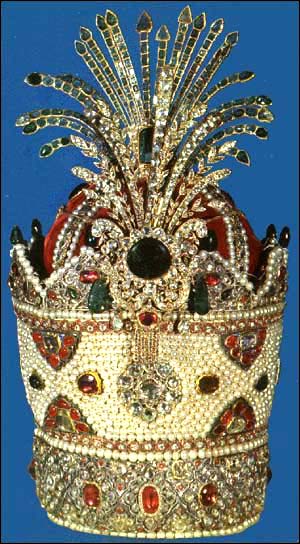



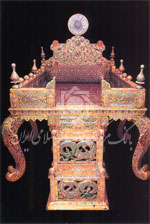 During the reign of Fath-Ali Shah and by his order, a great throne was made under the supervision of Nezamoldoleh Mohammad Hossein Khan Sadr Esfahani, the governor of Isfahan. Using gold and the loose stones of the treasury. (Early 19th century). As a design of sun encrusted with precious stones was used at the top of the throne, it became famous as the “Sun Throne”. After the marriage of Fath-AliShah with Tavous Tajodoleh, due to her name, the throne was named “Peacock Throne”. Some Iranians thought that the above throne was the same brought from India but according to the definition of Tavernier from “Peacock Throne” and their own gatherings they came to the conclusion that it can not be the genuine “Peacock Throne.” In order to confirm this view, they discussed the matter with Nasser-ed-din Shah and at last became sure that this “Peacock Throne” was constructed by the order of Fath-Ali Shah and was named after his favorite wife Tavous Khanoum or Lady Peacock as “Peacock Throne”.
During the reign of Fath-Ali Shah and by his order, a great throne was made under the supervision of Nezamoldoleh Mohammad Hossein Khan Sadr Esfahani, the governor of Isfahan. Using gold and the loose stones of the treasury. (Early 19th century). As a design of sun encrusted with precious stones was used at the top of the throne, it became famous as the “Sun Throne”. After the marriage of Fath-AliShah with Tavous Tajodoleh, due to her name, the throne was named “Peacock Throne”. Some Iranians thought that the above throne was the same brought from India but according to the definition of Tavernier from “Peacock Throne” and their own gatherings they came to the conclusion that it can not be the genuine “Peacock Throne.” In order to confirm this view, they discussed the matter with Nasser-ed-din Shah and at last became sure that this “Peacock Throne” was constructed by the order of Fath-Ali Shah and was named after his favorite wife Tavous Khanoum or Lady Peacock as “Peacock Throne”.
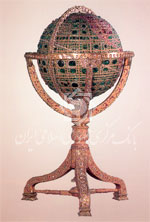
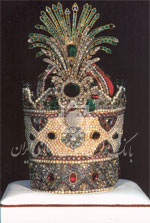
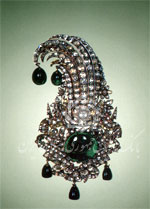
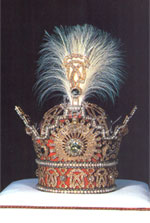 Crown used by Reza Khan and Mohammad Reza Pahlavi. This crown is made of gold and silver, and decorated with diamonds, emeralds, sapphires and pearls. The fabric of the crown is red velvet. On the 4 sides of the crown are battlement designs and also sunbursts on the four panels, totally set in diamonds. The general design is in the style of the crown of the Sassanid kings (226-651 AD). Inside the front sun design, there is a very large yellow diamond. The total number of the precious stones set in this crown is as follows:
Crown used by Reza Khan and Mohammad Reza Pahlavi. This crown is made of gold and silver, and decorated with diamonds, emeralds, sapphires and pearls. The fabric of the crown is red velvet. On the 4 sides of the crown are battlement designs and also sunbursts on the four panels, totally set in diamonds. The general design is in the style of the crown of the Sassanid kings (226-651 AD). Inside the front sun design, there is a very large yellow diamond. The total number of the precious stones set in this crown is as follows: The famous Darya-i-Nur or Sea of light is the largest pink diamond of the world and takes the first place among the diamonds in the National Treasury of Iran. This famous diamond along with its mate, the Kooh-i-Nur, or Mountain of Light, perhaps due to similarity of names, has always come together in history, although there is no similarity in cut or color between these two diamonds. Both of these stones were in the possession of Nadir Shah. After his death, Ahmad Shah Durrani took Kooh-i-Nur ti Afghanistan. After Ahmad Shah, it passed on to Shah Shuja, and after the defeat of Shah Shuja by Ranjit Singh the Lion of the Punjab, it passed into his possession. Later East India Company obtained it and presented it as a gift to Queen Victoria. It is presently in the Queen Mother’s Crown in England.
The famous Darya-i-Nur or Sea of light is the largest pink diamond of the world and takes the first place among the diamonds in the National Treasury of Iran. This famous diamond along with its mate, the Kooh-i-Nur, or Mountain of Light, perhaps due to similarity of names, has always come together in history, although there is no similarity in cut or color between these two diamonds. Both of these stones were in the possession of Nadir Shah. After his death, Ahmad Shah Durrani took Kooh-i-Nur ti Afghanistan. After Ahmad Shah, it passed on to Shah Shuja, and after the defeat of Shah Shuja by Ranjit Singh the Lion of the Punjab, it passed into his possession. Later East India Company obtained it and presented it as a gift to Queen Victoria. It is presently in the Queen Mother’s Crown in England.